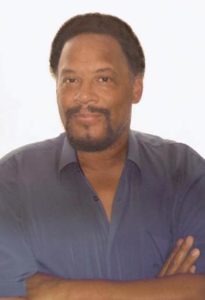
David Russell
David Russell was born on this date in 1950. He is a Black visual storyboard artist, educator, and painter.
He was born in Los Angeles to James Russell, a pilot with the Tuskegee Airmen. His grandfather, Lindsay Russell, was an LA police officer, and his uncle, Clayton Russell, was an activist LA minister. His maternal grandfather, Michael Taylor, was a Black Seminole and a member of the only Native American nation that was never defeated by the U.S. military. Russell says these family influences filled him with courage, determination, and an unwillingness to accept a predetermined role in life.
From an early age, Russell’s imagination was stimulated by reading adventure, fantasy, science fiction, and mythology stories. He read Dumas’ "The Three Musketeers" and many other classics, and in the early 1960s, discovered the imaginative work of comic book artist Jack Kirby. As a teenager, Russell decided to become a comic book artist and began providing superhero illustrations to the escalating comic fanzine market.
Russell attended Pasadena City College for two years, majoring in art. In 1972, he met Jack Kirby, who became his life-long close friend and mentor. That same year, he won a full scholarship to the prestigious Art Center College of Design. He finished at Art Center in 1974, moved to Seattle, and worked as a book illustrator, muralist, and creative director on numerous theme events. While there, he met Yugoslavian-born sculptor Masha Marjanovich and began a life-long partnership.
In 1981, Russell returned to Los Angeles to work as a storyboard artist on children’s animation shows. In this profession, he creates a somewhat comic book version of the film on paper, allowing the director to plan his shots, modify them, and improve the power of the script. This experience opened his eyes to more extensive possibilities, and within a year, he was seeking work in the saturated and competitive live-action film industry. In late 1982, Russell’s friend and mentor, science fiction writer Jack Vance, arranged an interview for Russell at Industrial Light and Magic. As a result, he was hired as a Visual Effects storyboard artist for "Star Wars: The Return of the Jedi."
Upon completing his Lucas film assignment, Russell returned to Los Angeles and was still shut out from working in Hollywood. Russell also learned that the Union itself had never had a Black American member, though not, he notes ironically, for a lack of qualified Black artists applying. In 1985, at the recommendation of Union illustrator Ed Verreaux, Russell interviewed for a storyboard artist position on the film "The Color Purple" and was hired. Here, he broke into the Union, making history as its first Black member.
From that point, Russell’s progress in the industry was swift; he established a reputation as one of the field's most versatile and imaginative illustrators and storyboard artists. His strong storytelling sense, dynamic compositions, and familiarity with the language of the film made him the illustrator of choice for many of the best directors in the business. His projects included "Who Framed Roger Rabbit?," "Batman, A League of Their Own," "Terminator II," "Harlem Nights, "The Santa Claus (e), "Higher Learning," and "Tombstone.
Russell learned early in his career to pick his projects carefully. He routinely avoids scripts that he feels are morally, politically, or racially offensive. In 1993, Russell traveled to Australia and was fascinated by the country and its Aboriginal culture. By 1996, Russell, a student of history, realized that the U.S. was moving towards what he felt was a fascist state. He and his wife decided to relocate to Australia. There, he has continued his career, working on such diverse films as "The Thin Red Line," "Vertical Limit," "Moulin Rouge," "The Quiet American," "The Man Who Sued God," "Master and Commander," and "The Lion, The Witch, and The Wardrobe.:
In 2001, Russell began holding seminars on the art of storyboarding and production illustration. He has presented his classes in Australia, Switzerland, Norway, and Holland. He has also shifted in a new direction as a fantasy writer and published his first novel, "Hidden Magic."
Russell has worked in Seattle with disadvantaged children under the Artists-in-the-Schools program and in LA on several mural projects with the SPARC organization. Deeply involved in Aboriginal affairs in his adopted country, Russell acted as Creative Director of the 2000 Sydney Olympics Aboriginal Arts and Culture Pavilion, which drew the highest attendance of any non-athletic event.
In his free time, Russell is an impressionist painter and portrait artist. His Jedi storyboards form part of the Smithsonian’s original "Star Wars" film art collection, which George Lucas donated. In 2003, the Australian government awarded David Russell permanent residency under the exclusive category of International Distinguished Talent. In 2008, George Lucas invited Russell to design key action sequences in Red Tails, including the powerful opening attack scene. Russell, whose father, James C. Russell, was a decorated Tuskegee Airman, was thrilled to work on the production.
Russell, who has now contributed to over 90 productions, continues to work on challenging films with his unique storytelling style.
John Andrews
Ozma Productions
155/15 Albert Avenue
Broadbeach, QLD 4218 Australia